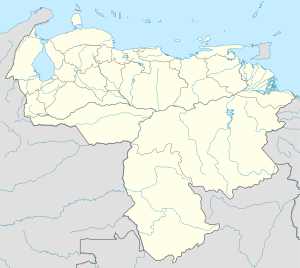
La Guaira (Spanish pronunciation: [la ˈɣwai.ɾa]) is the capital city of the Venezuelan state of Vargas and the country's chief port. It was founded in 1577 as an outlet for Caracas, 30 kilometres (19 mi) to the southeast. The town and the port were badly damaged during the December 1999 floods and mudslides that affected much of the region. Today, La Guaira exports cocoa beans, coffee, and tobacco.
The city hosts its own professional baseball team in the Venezuelan Professional Baseball League, the Tiburones de La Guaira. They have won seven national championships since their founding in 1962.
| |

La
Guaira
| |
| Coordinates: 10°36′0″N 66°55′59″W / 10.6°N 66.93306°W | |
| Country | |
| State | Vargas State |
| Founded | 1555 |
| Population | |
| • Metro | 270,792 |
La Guaira (Spanish
pronunciation: [la
ˈɣwai.ɾa]) is the capital city of the Venezuelan state of Vargas and the
country's chief port. It was founded in 1577 as an outlet for Caracas, 30 kilometres (19 mi)
to the southeast. The town and the port were badly damaged during the December 1999 floods and
mudslides that affected much of the region. Today, La Guaira exports cocoa
beans, coffee, and tobacco.
The city hosts its own professional
baseball team in the Venezuelan
Professional Baseball League, the Tiburones de La
Guaira. They have won seven national championships since their founding in
1962.
La Guaira Bank
La Guaira
Bank (Spanish: El Placer de La Guaira) is an underwater ridge that
is approximately 12 miles[vague]
off the coast from the city of La Guaira in Venezuela. The
bank is approximately
12 miles (19 km) long from east to west and 4 miles (6 km) wide from north to
south, and it rises from 50 fathoms (90 m) in the surrounding area to 140
fathoms (260 m). The area provides the structure deep-sea animals, and other
organism such as gorgonians, sponges, and coral, require for ocean currents
to bring their food to them. Westerly currents flow off the coast of Venezuela,
and the bank acts as a barrier to this current, creating an upwelling of nutrients to the
ocean surface from deep-water stockpiles. These nutrients fuel an explosion of
planktonic
plant and animal growth, and attract larger animals such as whales, porpoises, seabirds, and large pelagics such as tuna, sharks, wahoo, dolphinfish, and four
different types of marlin. It is considered one of
the top sport fishing destinations
of the world due to the unusually high numbers of blue marlin, white
marlin, sailfish, and spearfish that
congregate at different seasons, and are available year round.
The Venezuelan government, understanding the importance of the sport fishing industry to the community as well as the need to protect this fishery, has enacted regulations that protect these waters from industrial commercial fishing by establishing a fifty-mile-long protection area, allowing only small-scale traditional fishing.
The Venezuelan government, understanding the importance of the sport fishing industry to the community as well as the need to protect this fishery, has enacted regulations that protect these waters from industrial commercial fishing by establishing a fifty-mile-long protection area, allowing only small-scale traditional fishing.
History

After the founding of Caracas by Spanish in 1567, toward the turn of
the 16th century, the Port of La Guaira emerged on the coast and, since that
time, has been the gateway to Caracas. This coastal city, almost without land to
develop and bathed by the Caribbean Sea, became an important harbour during the
18th century. Attacked by buccaneers and by the English, Dutch, and French
armadas, La Guaira was transformed into a fortified, walled city. During the War of Jenkins'
Ear (1739–1748), the Battle of La Guaira
took place off the coast of La Guaira. This period also saw the trading monopoly
of the Royal
Gipuzkoan Company of Caracas, which controlled the major ports of La Guaira
and Puerto Cabello and was
instrumental in the development of large-scale cocoa production along the
valleys of the coast. Another small naval battle was
fought off La Guaira in 1812, between privateers of the United
States and the United Kingdom. Now this
is the second port by importance in Venezuela after Port of Puerto Cabello.
Source: Wikipedia free encyclopia
Source: Wikipedia free encyclopia

No comments:
Post a Comment